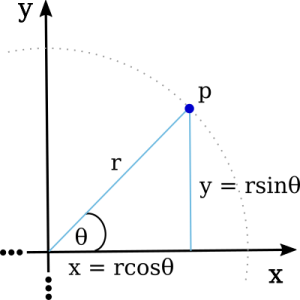In my last post about binary signed integers, I introduced the ones complement representation. At the time, I said that the ones complement was found by taking the bitwise complement of the number. My explanation about how to do this was simple: invert each bit, flipping 1 to 0 and vice versa. While it’s true that …
Category: Math
Jul 26 2016
Binary Signed Integers – Ones Complement
In the last post, we saw that one of the major failings of the signed magnitude representation was that addition and subtraction could not be performed on the same hardware as for unsigned integers. As I pointed out, the reason for this is because negating a number in signed magnitude does not yield the additive …
May 02 2016
Circular Motion
From the orbits of celestial bodies, to cars hurtling around a racetrack, to electrons zipping around the nuclei of atoms, examples of objects in circular motion can be found in a wide variety of scales and speeds. This post is about the generic case: a point particle moving at a constant speed along the circumference of a circle. This …
Mar 09 2016
Unsigned Binary Integers and Internal Congruence
This is going to be another one of my “selfish” posts – written primarily for me to refer back to in the future and not because I believe it will benefit anyone other than me. The idea is one that I always took for granted but had a hard time proving to myself once I decided …
Feb 01 2016
Binary Signed Integers – Signed Magnitude Shortcomings
I previously discussed the signed magnitude solution to representing signed integers as binary strings and pointed out that while it had the advantage of being simple, it also has some disadvantages. For starters, N-bit signed magnitude integers have two representations for zero: positive zero (a bitstring with N zeros) and negative zero (a bitstring with …
Jan 14 2016
Proof of the Power Rule
If you’ve got the word “power” in your name, you’d better believe expectations are going to be sky high for what you can do. The Power Rule in calculus brings it and then some. The Power Rule, probably the most used rule when differentiating, gives us a drop dead simple way to differentiate polynomials. Specifically …
Jan 12 2016
Modular Exponentiation Rule Proof
It is no big secret that exponentiation is just multiplication in disguise. It is a short hand way to write an integer times itself multiple times and is especially space saving the larger the exponent becomes. In the same vein, a serious problem with calculating numbers raised to exponents is that they very quickly become …
Jan 03 2016
The Complete Idiots Guide to Calculus
Title: The Complete Idiot's Guide to Calculus Author: W. Michael Kelley Genre: Mathematics Publisher: Penguin Release Date: 2006 Pages: 336 Let’s face it: most students don’t take calculus because they find it intellectually stimulating. It’s not . . . at least for those who come up on the wrong side of the bell curve! There …
Jan 02 2016
Modular Multiplication Rule Proof
I must stay focused. I must stay focused. I must stay … I wonder what’s new on Facebook. I don’t really feel like writing this post mostly because I know that it will be very similar to the other two I have already done: modular addition rule proof and modular subtraction rule proof, but my New …
Jan 02 2016
Artificial Intelligence: A Modern Approach
Title: Artificial Intelligence: A Modern Approach Author: Stuart Jonathan Russell, Peter Norvig, Genre: Computers Publisher: Prentice Hall Release Date: 2010 Pages: 1132 Artificial intelligence: A Modern Approach, 3e,is ideal for one or two-semester, undergraduate or graduate-level courses in Artificial Intelligence. It is also a valuable resource for computer professionals, linguists, and cognitive scientists interested in …


